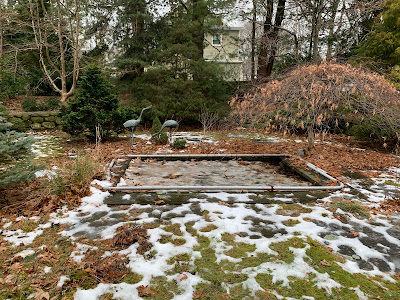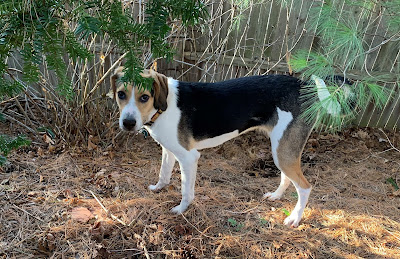 |
| Robin Wilkerson's Lincoln, MA garden in August 2017 - a pollinator feast |
May and June bring the most flowers in my garden, with another surge in October. My goal is to boost “floral resources” from July through September, when there’s less forage available for pollinators here. To produce the most flowers for visiting bees, flies, beetles, moths, and butterflies, the new plants will need as much sun as they can get in our yard. That’s why I’ll plant them around the garden pond, one of the sunniest areas. To date, the pond been surrounded on three sides by dwarf conifers, a Japanese maple, and a few perennials.
 |
| Looking sad now, but you can see there's some space for flowers |
When the molded plastic pond liner was installed in 1997, its rim was covered with long pieces of bluestone, and smaller bluestone rectangles were dotted around it in a pleasing irregular pattern. I’m proposing to lift the smaller stones where I can to make space for summer bloomers.
Most of my summer flowers are yellow or orange. Around the pond, I’m going with purples and pinks. Working from lists from Kim’s website, ecobeneficial.com, and the Native Plant Trust, I’ve chosen some possibilities. They’re all native to Massachusetts, and this time I’m going to insist on straight species, not cultivars.
A cultivar is a plant that’s been selected from among the natives and reproduced asexually—through cuttings, divisions or tissue culture—to preserve some desirable characteristic. The problem is that new traits humans like may confuse insects, as when flower color or bloom time changes. In general, I’ve accepted cultivars that look similar to the straight native species as sustainable enough, but not this time. This bed will be completely pure.
 |
| This yellow tickseed, Coreopsis 'Zagreb,' is a cultivar that looks like the straight native species |
Here are some of my choices: I’ve been wanting to grow Joe Pye weed (Eutrochium maculatum) or its coastal cousin (Eutrochium dubium).
 |
| Joe Pye weed |
I’ll give anise hyssop (Agastache foeniculum) another chance.
 |
| Anise hyssop-photo R. A. Nonenmacher |
I’ve stayed away from beebalm because I feared it would take over the garden. Now I’ll try some, possibly spotted beebalm, AKA horsemint (Monarda punctata), which has intriguing flowers combining pinkish-purple, green, beige, and maroon.
 |
| Distinctive horsemint flowers |
I’ve got to try mountain mint (Pycnanthemum muticum), which also has muted flower colors. It’s reputed to be a superstar for attracting pollinators.
 |
| Mountain mint is a pollinator magnet |
And asters will fill in the gaps, not just late-blooming New England aster (Symphyotrichum novae-angliae) but possibly also New York aster (S. novi-belgii) or smooth aster (S. laeve), both of which flower during my preferred summer window.
 |
| Smooth aster starts blooming in early September-photo Heike Löchel |
I’m hoping to combine different flower forms, from the daisy-shaped aster flowers to beebalm’s tubes and Joe Pye weed’s compound balls. That’s to cater to the preferences of the different insects I hope to attract.
 |
| Butterflies with long tongues can sip from tubular flowers |
I may even be able to avoid plastic pots and buy some of these as bare root plants. Updates will follow.

















